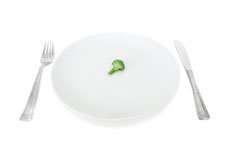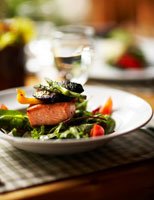Portion Sizes Can Be Deceptive
 It is no secret that as food portions have grown over the past 20 years, so have the waistlines of Americans. How much do these increased portion sizes really affect how much we eat? The answer may surprise you.
It is no secret that as food portions have grown over the past 20 years, so have the waistlines of Americans. How much do these increased portion sizes really affect how much we eat? The answer may surprise you.
Portions Larger Than You Think
Portion sizes and serving sizes are different today which greatly impacts our calorie consumption. A serving is a standard measure, such as a cup, a half cup, an ounce, etc. Portion size, on the other hand, is the amount of food offered to a person at a restaurant, in a package, or the amount someone chooses to put on their plate.
Muffins and bagels are perfect examples of portion discrepancies. Many times these foods are sold in sizes that constitute more than one serving. We eat the entire thing, thinking it was a serving, when in reality the portion may be as many as four or five servings. YIKES!
Portion sizes may not matter if a person chooses to eat only a serving rather than the entire portion they are served, or if individuals eat fewer calories at subsequent meals or snacks to balance overall calorie intake. However, this isn’t often the case.
Large Servings Are Hard to Resist
Studies show that people do not intuitively assess appropriate serving  sizes, they don’t consume the proper serving size when a larger portion is offered, and they fail to adjust their calorie intake later in the day to balance out daily calories once they have consumed larger portions.
sizes, they don’t consume the proper serving size when a larger portion is offered, and they fail to adjust their calorie intake later in the day to balance out daily calories once they have consumed larger portions.
A study¹ tested how adults responded to different portion sizes of macaroni and cheese on four different days. They found that the more these adults were served, the more they ate. In fact, they consumed about 162 more calories when offered the largest portion compared to the smallest portion.
In another study², participants were served soup for 3 days and their intake was recorded. On the fourth day, they were served soup in trick bowls which were refilled from a reservoir hidden under the table. The people ate more than their normal serving when the bowls were continuously refilled. When the participants were told about the trick, their intake was then measured for another 6 days. Normal weight individuals adjusted their intake while the obese participants did not.
Studies done on children have yielded similar results. One in particular³ measured children’s bite size and intake of an entrée. Intake rose by 25% with the larger portions than with age-appropriate or self-selected portions.
Taking Control of Your Portions
Knowing this, it is essential that we become more aware of how portion size can impact our intake and develop strategies to avoid common portion pitfalls.
- Start by reading labels and understanding how increased portions can translate into excess calories. A portion distortion quiz can be found here and really illustrates how portions and calorie content of foods have increased over the past 20 years. Here you can also find a printable pocket serving size card.
- Manage large portions at restaurants by asking the server to bring a carry-out container with your meal, ordering smaller portions or splitting entrées.
- While at home, take steps to control overeating too. Instead of placing serving dishes directly on the table, dish up reasonable amounts of food on smaller plates. Manage hunger and avoid overeating at meals by choosing healthy snacks between meals. Resist the urge to eat in front of the TV or directly from a package.
- Finally, take control of your environment. Make tempting foods and bulk food portions less visible and available. Remember, out of sight means out of mind.
¹ Rolls et al. AJCN 2002.
² Pudel and Oetting. 1977.
³Fisher JO, Rolls BJ, Birch LL ,Amer J Clin Nutr 2003;77(5):1164-1170.